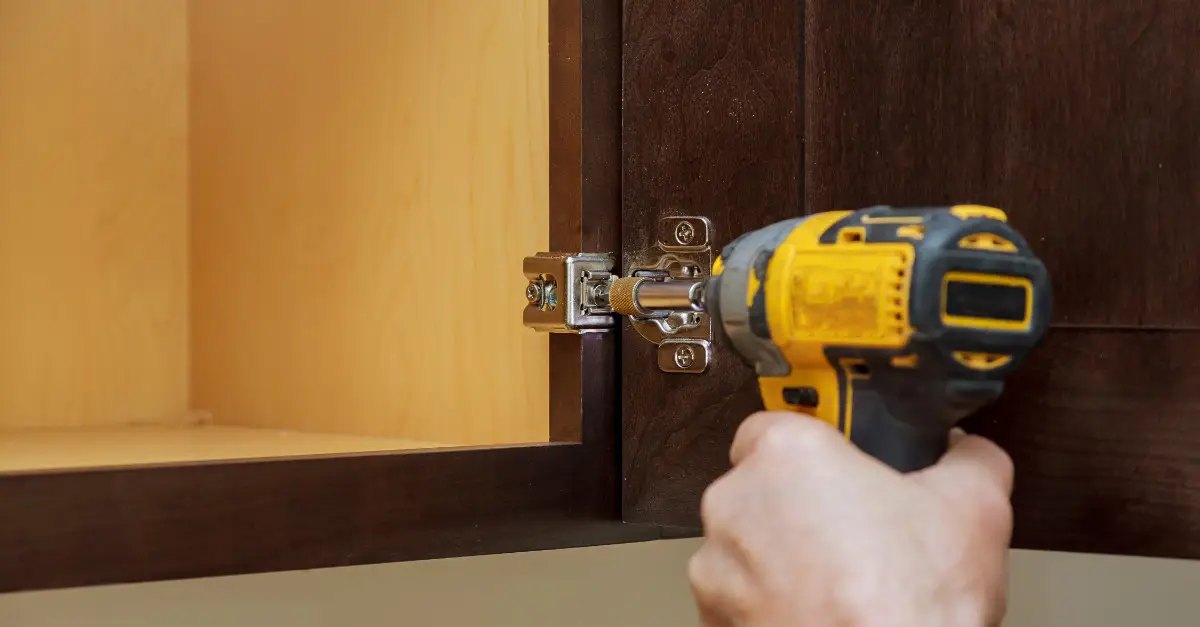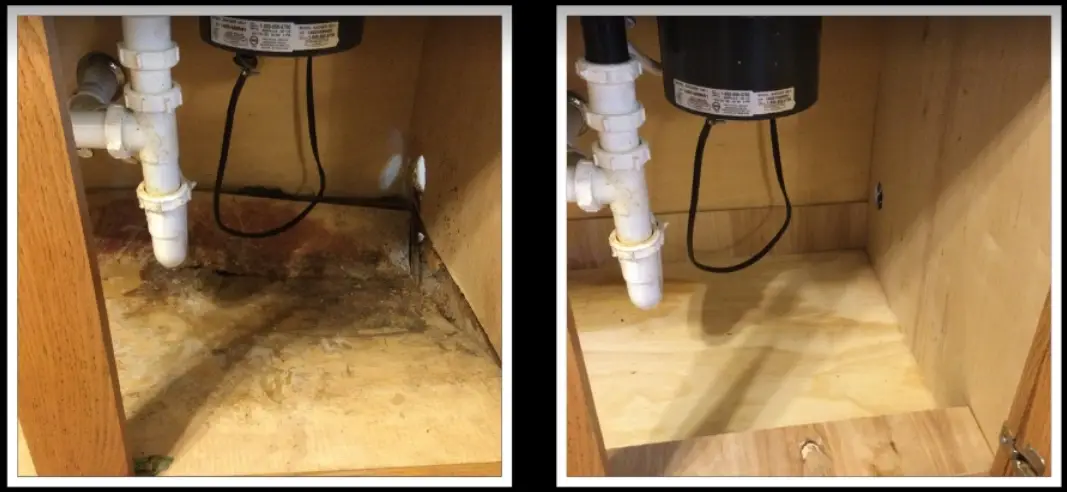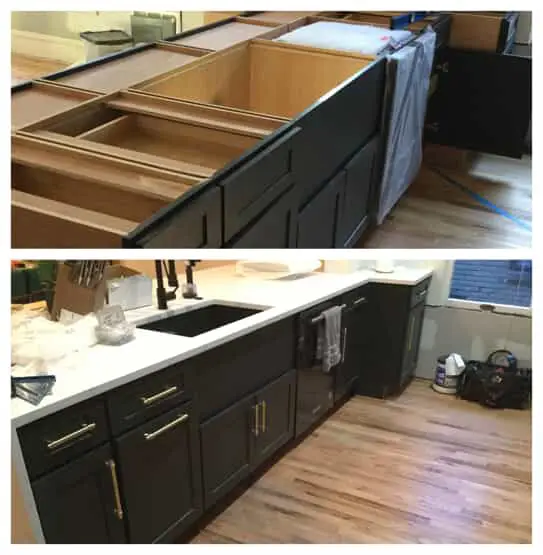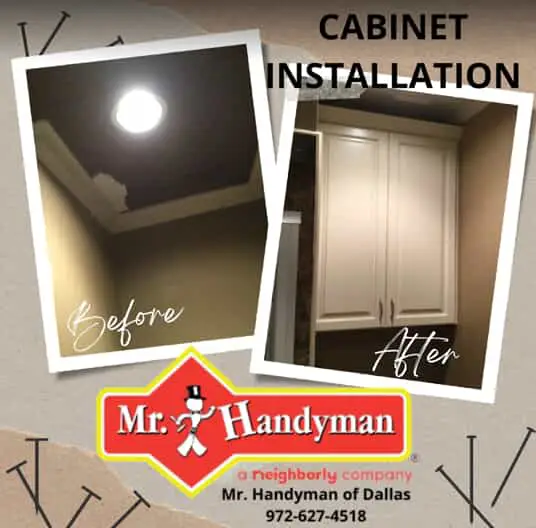Cabinet Repair 101: What to Know About Restoring Your Cabinets

Your kitchen cabinets take up the most real estate in the room. This is why their state and design can really impact the overall functionality of your kitchen. Perhaps your kitchen cupboard doors have been recently damaged or you’ve been putting off a few cabinet maintenance tasks, and you need help getting your cupboards in working condition again. Whatever the case may be, there are a number of important factors in deciding if replacing or repairing cabinet doors is best for you, and what kinds of repairs are best suited for your existing cupboards.
Because there is a lot to learn about repairing cabinet doors, our expert Dallas handyman team has created this blog post to walk you through what you need to know to fix up your cupboards. Read on to discover when it’s worth repairing cabinet doors rather than replacing them, steps to some basic cupboard repairs and when to call the pros at Mr. Handyman of Dallas.
Replacing vs. Repairing Cabinet Doors
Before diving into our how-to guide for repairing cabinet doors, it’s important to understand if you should repair them in the first place. Cabinet refacing and repairs are typically best performed on existing cabinet boxes that are otherwise in good condition. If you have any of the following signs of damage, then it is probably not worth spending any time refinishing or painting your cabinets instead of replacing them completely.
Water Damage
If your wood has light water damage—say you spilled a glass of water in your wood cabinets and they have warped slightly—then you may still be able to consider repairing cabinet doors. However, if your cabinets no longer close properly, they are bubbling, or the wood has started to blacken, then you may want to consider replacing your water-damaged kitchen cabinets instead.
In the two images below, you can see that this cabinet had a high degree of water damage and required partial replacement. Replacing the entire cabinet is not always necessary, and in this case, we replaced part of the cabinet box while leaving the doors intact.


Lacking Functionality
No matter how beautiful your shelving might be, if your kitchen's design and flow are just not working for you, repairing cabinet doors and boxes might not be as beneficial as replacing your cupboards. Investing in custom built-ins is a great way to get the most out of your cabinetry. For instance, you will likely want to replace your cupboards if they are:
- Difficult to access
- Out of your reach
- Open incorrectly or consistently get stuck
One of our customers was dissatisfied with their kitchen's layout and a lack of storage space. They also wanted a larger kitchen island, so we replaced their existing cabinets with new ones and installed a new counter to match.

Discoloration
If you are noticing black, green or white discoloration around your shelving, repairing cabinet doors, boxes and drawers is not an option. Unfortunately, your cabinets have been damaged beyond repair and your only choice is to track down the source of discoloration, find a way to prevent further discoloration and install brand-new cupboards.
In the image below, existing cupboards in a nook of our customer’s home were damaged beyond repair. We removed the existing unit, filled in minor ceiling damage that occurred during the removal process and installed a brand new cabinet using our extensive knowledge of cabinet installation best practices.

Common Cabinet Repairs
Sometimes your cupboards have fixable damage that can be easily repaired by our expert technicians to help you avoid having to replace your cabinets. Common problems with shelving that are easily solved by our skillful team include:
Adjusting Hinges On Misaligned Doors
If your kitchen cabinet doors are not aligned correctly, it’s most likely that either the side screw, depth screw or a screw that moves your kitchen cabinet door up or down needs to be adjusted. Repairing cabinet doors that are misaligned involves understanding how standard door hinges work:
- Side screws impact whether your cupboard doors are properly aligned to the left and right.
- Depth screws impact how far back or how far forward your cupboard door is.
- Some cupboards are built with a screw that moves them up or down. If this is not the case and one door is higher than the other, you will have to adjust your cabinet by loosening its mounting screws.
In each of these instances, you will have to find the correct screw that impacts the cabinet hinge problem you are trying to fix. Then, simply tighten, loosen and adjust your cupboard doors as you see fit until they are realigned.
Replacing Latches That No Longer Close Correctly
Most new cupboards have self-closing hinges that keep their doors shut. However, some cupboards use magnetic or roller catches. Should any of these latches become damaged, you have two options for repairing cabinet door latches:
- Replace the latch: Simply visit your local hardware store, buy a new latch, unscrew the old latch, and screw in a new latch.
- Adjust the latch: If the latch seems fine but your cupboard doors are still not closing, you might have to fiddle with its catch a bit until it works again. Loosen all screws holding the catch in place, move it in or out, and retighten the screws. Repeat until the latch works correctly.
Adding Bumpers to Existing Cabinet Doors
This method for repairing cabinet doors is truly a breeze. To prevent cupboards from banging shut, purchase a pack of peel-and-stick door bumpers at your local hardware store. Then—ensuring your cupboard doors are clean so the bumper sticks—place one bumper at both the top and bottom corners of your cupboard doors.
Gluing Loose Cabinet Knobs
Is your cabinet knob loose even though you have tried tightening its screw? If so, this indicates that the problem is with the screw itself. But before you get worried that you will have to buy new knobs or that the screw is scratched, try gluing the knob first. To do this, select a thread-locking adhesive and apply a small amount to the screw. Then, slide the knob back onto its screw and let it dry.
If you want to replace your kitchen knobs later, you can break this adhesive with a screwdriver.
Filing Stripped Screw Holes
While a stripped screw hole may seem like a hassle to fix, it is actually a fairly easy fix for repairing cabinet doors. First, remove the screw and the cabinet door knob. Then, dip toothpicks in wood glue and place as many as you can into the hole. Break off the toothpick ends and wipe away any excess glue. Then simply reinstall the door knob by screwing it directly into the toothpicks.
Touching Up Nicks And Scratches
Do you have unsightly nicks and scratches in your cupboard doors, but not enough to justify refinishing your shelving unit entirely? Instead of repairing cabinet doors entirely, use a stain-filled touch-up marker to color in any scratches. Simply dab on this stain and wipe away any excess. Deeper gouges can be repaired with wood filler.
Pro Tip: Use a stain that is slightly lighter than your existing shelving. Cabinet scratches absorb stain very easily, so it is possible that they may look darker than the rest of your cupboard doors if you do not use a lighter stain.
Repairing Broken Door Hinges
If your hinge has snapped off your kitchen cupboard, then your best option for repairing cabinet doors is to repair holes with gap-filling glue. First, remove the hinge from the damaged door. Then, apply petroleum jelly to all moveable parts of the hinge. This will protect them from the glue.
Next, scuff up the part of the hinge that will come in contact with the glue. This will help make it stick better. Apply glue to the damaged part of the door and immediately reinstall your hinge and screws. Use clamps or weights to keep the hinge in place while the glue dries.
Cleaning Rusty Hinges
Cleaning rusty hinges is an easy process, but it does require a little patience. Follow these steps to repair rusty hinges:
- Remove latch and screws.
- Scrub with steel wool to remove as much rust as possible.
- Place rusty hardware in a container.
- Fill container with cola. Sodas contain phosphoric and carbonic acids, which remove rust.
- Wait three hours and check to see if the rust has been removed. Continue this process every three hours until all signs of rust are gone.
- Clean hinge in warm, soapy water and dry completely.
- Reinstall hinge.
Refinishing vs. Painting Cabinets
Sometimes your shelving units have become so damaged or outdated that a quick fix is not the best solution. If this is the case—and if your shelving units are still structurally sound—then, consider refinishing your shelves instead of replacing them.Both strategies offer different benefits and drawbacks.
Pros and Cons of Refinishing Cabinets
This cabinet repair option is time-consuming, but can also make your kitchen look like new. Pros of refinishing your cabinets include:
- Creating a traditional, natural look
- Supplies will cost you less than painting your cabinets
- DIY mistakes are more forgiving
- Hides dirt well
- Lasts a long time
- Easier to wash
- Less prone to cracking
- Showcases the natural wood grain of your cabinets
- The classic and natural look could increase your home's resale value
Cons of refinishing your cupboards include:
- Stained wood cabinets are less resistant to water than painted cabinets
- Shows dust more than painted cabinets
- Harsh cleaners can dull its finish
- Harder to remove stains if your refinished shelves are not cleaned right away
Pros and Cons of Painting Your Cabinets
Maybe you would prefer a sleeker and more streamlined look in your kitchen compared to the more traditional aesthetic of staining your cabinets. Instead of refinishing them, consider painting your old shelving units instead. Pros of painting your cabinets include:
- Creates a smooth, modern look
- More color options than staining cabinets
- Hides dust more than stained cabinets
- Can apply a top coat to make cleaning easier
- Neutral colors add to the resale value of your home
Cons of painting your cabinets include:
- More expensive than staining your cabinets
- Can be more time-consuming
- Mistakes show more easily
- Lasts less than staining
- More prone to cracks and chipping
- It’s more difficult to touch-up
- Bold colors can detract from the resale value of your home
How to Refinish and Paint Your Cabinets
If painting or refinishing your cabinets sounds like the right option for repairing cabinet doors and boxes in your home, follow the below steps to give your kitchen cupboards a boost. Both painting and staining follow a very similar process.
If you have experience with these techniques, you can attempt this project on your own. For a professional appearance that lasts for years to come, using the services of a professional handyman team is the way to go.
- Ascertain what kind of products you will need: Depending on what material your shelves are made out of, you will need different types of paint. For example, metal and wood are easy to paint over with a standard water-based product, but plastic laminate cabinets require special paints. Likewise, stain will only work on wood cabinets. Be sure to do a patch test on your cabinets first to ensure you have chosen the right color.
- Label each cabinet door: Before removing your cupboard doors, label them to save you time when you have to put everything back.
- Remove wooden cabinet doors and hardware: We advise that you do not paint your cupboard doors inside. Rather, move them to a well-ventilated area like your backyard or deck.
- Clean the wood thoroughly: It’s very important to paint your cabinets on a clean surface—especially since the kitchen is one of the areas of your home that has the most grime build-up due to grease, oils and food splatters.
- Allow doors to dry completely: Before you proceed to sand your doors, they must be completely dry.
- Sand the surfaces: Lightly sanding your doors will prepare them for painting or staining. Sanding your doors will remove any existing paint or stain, smooth out the damaged area and ensure the paint/stain bonds properly with the cabinet surface.
- Wipe away the residual dust: Sanding can be quite messy, and before you apply your paint or primer to the bare wood you will need to wipe down your doors thoroughly.
If you are painting your cabinet doors:
- Apply the primer: Applying an even coat of primer will help your cabinet’s paint job stay even. Additionally, primer helps paint bond to your prepared doors.
- Paint your doors: Once the primer has dried, you are ready to paint your doors. Be sure to paint carefully and evenly. The best practice is to apply the paint in multiple thin layers until you have reached your desired coverage.
- Allow the paint to dry completely: Before reinstalling your newly painted doors, be sure they have completely dried.
Or If you are staining your cabinet doors:
- Use a rag to apply the stain: Using a rag will help you work the stain into the wood grain. Be sure to wipe away any excess stain. Keep staining until you have reached your desired color and have applied the stain evenly.
- Apply a polyurethane sealer: This will maintain your newly applied stain and prevent other liquids from damaging the wood. It’s best to apply two coats of sealer and allow the cabinets to dry completely before each coat. Once your final coat has been applied and the doors are completely dried, you may reinstall them.
Need Help With Repairing Cabinet Doors? Contact The Pros At Mr. Handyman Of Dallas!
Are your kitchen cupboards in desperate need of repair? Perhaps after reading this article you feel ready to tackle a DIY cabinet repair job on your own. However, if you would rather the experts handle your cabinet repair needs instead, Mr. Handyman of Dallas is here to help.
Mr. Handyman provides the expert services you need for cabinet repair and so much more throughout the greater Dallas area, including communities like University Park, Lancaster, and Rose Hill. Be sure to give us a call or request service online today.
 Click to call
Click to call


